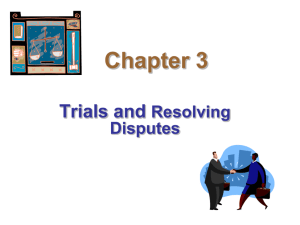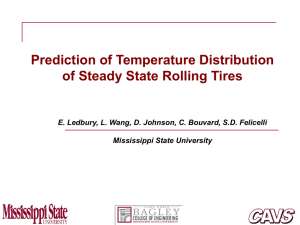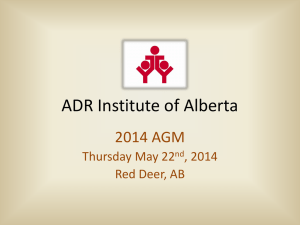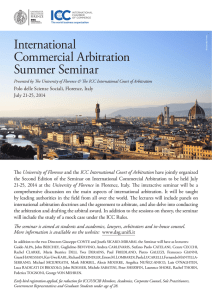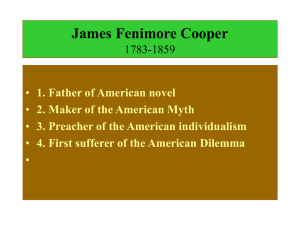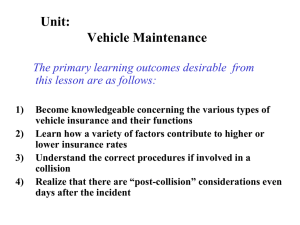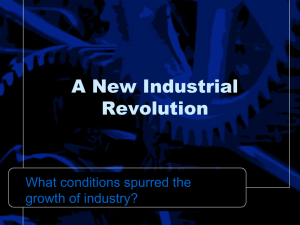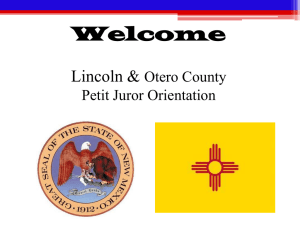Chapter 3 - Economics
advertisement
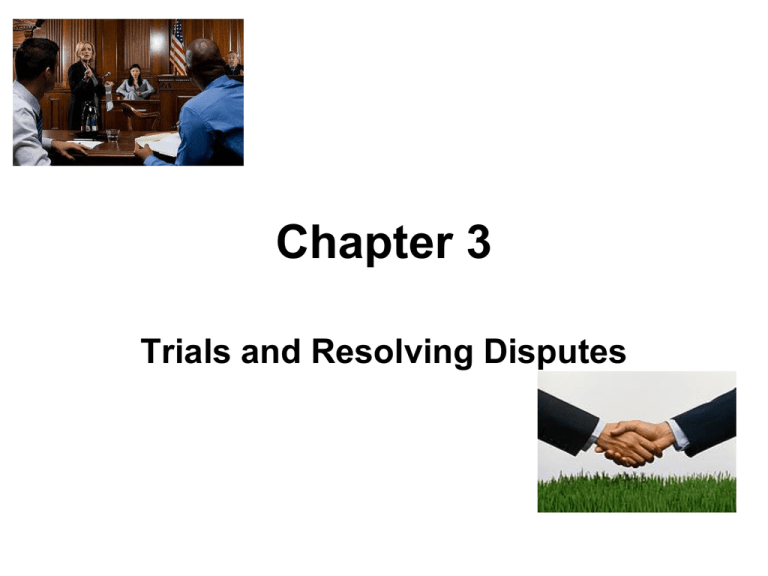
Chapter 3 Trials and Resolving Disputes The Judicial System • The court system is adversarial. • Parties have the responsibility for bringing a lawsuit, shaping issues, and presenting evidence. • Lawyers represent parties’ claims. • Judges don’t investigate. • Court applies legal rules to facts presented. • Trials are often costly and uncertain. • Complex facts, extensive evidence, mountains of business records can be involved. • Juries tend to be less sympathetic to businesses Basic Trial Procedures • • • • • • Pleading Stage Discovery Stage Pretrial Stage Trial Stage Appellate Stage Enforcement Stage • See Exhibit 3.2 The Pleadings Stage • • • • • Formal statements made to the court by the parties Jurisdiction needed over subject matter & parties Notice given of lawsuit by service of process by summons Complaint – Alleges facts for jurisdiction & remedy/remedies – Requests remedy(ies) – See Exhibit 3.1 (Casino owner pokes a hole in a Picasso, and sues Lloyds of London for compensation for losses under his insurance policy with them.) Responses to Complaint – Motion to Dismiss (Demurrer) • By defendant – Answer (may include affirmative defenses – usually by defendant) – Counterclaim – Reply Discovery Stage (Legal Tools to Obtain Evidence) • Rules of Civil Procedure set guidelines & limits to the process • Purposes: 1) preserve evidence, 2) limit surprises, 3) encourage settlement • Depositions of parties and witnesses (including experts) – sometimes videotaped • Interrogatories of the parties • Use of Expert Witnesses • Requests for Admissions • Orders of Production of Documents • Physical/Mental Examinations • Impacts on business – expensive & time-consuming • Court may sanction a party who fails to comply with discovery requirements . • – Default Judgment – Contempt of court (fines, pay costs to the other party) See Cooper Tire & Rubber v. Mendez “Is There Something Unclear About the Rule, Counselor?” • Federal suits: Rule 8a requires the initial pleading to be “short and plain”. • Rule 9b requires it to be to the point – to let the other party know what the lawsuit is about • Attorney Webb’s client was suing GMAC Mortgages • Submitted a 465 page pleading • Included 37 pages of quotes from e-mails • 341 pages largely repeated points made in assorted claims of various points • Federal District Judge Leighton was not amused. • Dismissed. Cooper Tire and Rubber v. Mendez • • • • • • • Mendez was driving a minivan – 6 passengers Rear tire, made by Cooper Tire, lost its tread. Minivan rolled over. 4 passengers killed. Mendez and 2 other survived. Examination showed nail had punctured the tire and it separated. Mendez and others sued Cooper for product defect. Jury awarded $11 million+ in damages. Appeals court affirmed. Cooper appealed that plaintiff’s expert testimony by Richard Grogan was inadmissible. • HELD: Reversed. Grogan’s presentation of a theory of wax contamination at manufacturing as a reason for the separation of the belts on the tire is unreliable and should not be admitted. • Expert testimony is admissible if (1) the expert is qualified and (2) the testimony is relevant and based on a reliable foundation. (CONTINUED) Cooper Tire and Rubber v. Mendez, cont. • Grogan is not a chemist, engineer or tire designer. Has a British certificate equivalent to a high school diploma. Not accident reconstruction expert. • He did work at Dunlop Tire in England, examining tires, including those that had failed. He teaches courses on tire failures and published a book entitled An Investigator’s Guide to Tire Failures, along with articles on tire failures. • Grogan’s theory of wax contamination is supported only by his book and theory has not achieved acceptance. • Cooper’s chemical engineer and two other Cooper experts testified that wax migration is a normal, expected, and understood phenomenon occurring during manufacture and the life of the tire. • Cooper’s experts testified: Wax migration is not a defect • Grogan’s novel theory does not meet the reliability standard for admission of expert testimony. • Grogan’s testimony is not evidence of a defect and tire failure; therefore case fails. Pretrial Stage • Summary Judgment – either party may request – Judge renders it • Pretrial Conference – either party or court may request – Usually attorneys and judge attend – Simplify issues – Plan course of the trial – Judges get parties to drop certain parts of case – Helps to focus on key issues – Judges often encourage parties to reach out-of-court settlement See Test Yourself, p. 64 Jury Selection • 6th and 7th Amendments gives right to a jury in certain cases • If no use of jury, judge becomes trier of fact • Selection of jury involves voir dire • Attorneys allowed limited number of challenges to reject prospective jurors without stating reason – peremptory challenges • Usually 12 persons on jury panel • Some states have fewer – such as 6 or 9 jurors Trial Stage • Opening Statements by attorneys • Presentation of Direct Testimony – Direct Examination, Cross Examination, Redirect Examination, Re-Cross Examination • See “You Got Me There, Counselor!” (Courtroom Bloopers) • Closing arguments • Instructions to Jury (also called charges) • Verdict by jury. (May be set aside for jury misconduct.) • Motions For A Verdict – Motion For A Directed Verdict/Motion For Judgment As A Matter of Law • Cases have been presented, but before going to jury, either party requests entering judgment in its favor – Motion for Judgment As A Matter of Law/Motion For Judgment Notwithstanding the Verdict (N.O.V.) See Exhibit 3.3 Remedies in Civil Litigation (See Exhibit 3.4) • Monetary damages • Equitable remedies – Compensatory – Punitive or exemplary – Nominal See Naples v. Keystone See George State Licensing Board – Specific performance – Injunction • Permanent • Temporary • Preliminary Naples v. Keystone Building and Development Corp. • • • • • • • • • • • The Naples contracted with Keystone to build their new home. Work was warranted. Cost was $620,000. Major problems occurred soon after they moved in. Crews were sent several times to do repair work. Problems continued Expert, Dykins, was hired to evaluate the home. Said extensive work would be needed. Estimated costs of repairs: $113,511 + painting for $15, 819. Naples sued Keystone for the amount. Trial court held for the Naples, awarding them $59,140. Stated that a higher damage figure had “not been established with a sufficient degree of certainty.” Naples appealed. (Continued) Naples v. Keystone Building and Development Corp., cont. • • General rule: Place the party entitled to compensation in position it would have been if there had been no breach In unfinished construction damages are measured by – 1) Reasonable cost of construction & completion, if this does not involve “unreasonable economic waste” OR – 2) Difference between value contracted for and value of performance that was received (without involving “unreasonable economic waste”) • • • • Repairs may not result in improvements on the property that go beyond the work that was warranted. The court did not point to conflicting evidence or explanation why it elected to discredit some portions of the estimate (trim, siding + repair & paint portions of interior) while accepting others verbatim. Trial court’s award was therefore illogical. HELD: Trial court was in error. New trial ordered and limited to issue damages to compensate plaintiffs adequately. Georgia State Licensing Board for Residential & General Contractors v. Allen • Georgia legislature passed a law: Contractors must have license issued by the Georgia Licensing Board for Residential and General contractors • Contractor must pass exam and other requirements. • If a county has a requirement at least as strict as state license process, contractor can operate under such license • Allen & 40 other contractors had licenses from Muscogee County • However, county’s licensing requirement not as strict as state’s • After year-long grace period, Board held these contractors not properly licensed & could not work until properly licenses • Many contractors did not know of new requirement – county did inform them of the new rules • Contractors sued Board and County for injunctive relief • Said if can’t work, would suffer “irreparable harm” (Continued) Georgia State Licensing Board for Residential and General Contractors v. Allen, cont. • Trial court granted preliminary injunction against enforcement of Board’s licensing procedure. Board appealed. • HELD: Reversed. Ignorance of the law by contractors is no excuse. • Contractors were served with “notice” of the new law when statute was passed by the Georgia legislature. • Granting this injunction should only be if danger to one party is great, while possible harm to another is minimal. • Granting the injunction “operated oppressively” on rights of the Board and the general public. • New licensing statute was “in the interest of public health safety & welfare” and to safeguard members of the public • Plaintiffs not w/o remedy if they challenge the law and win • Plaintiffs did not show they could not lodge claims for monetary damages from lost work or business opportunities as a result of the law during applicable periods of time. • Injunctive relief is not appropriate here. Appellate Stage (Appeal Based on Error of Law) • Arguments before the court – Written Briefs – Oral Arguments • Decisions by the court – Majority opinion – Concurring opinions – Dissenting opinions • Outcomes of decisions – Affirmed – Modified – Reversed – Remanded Enforcement Stage • If no further appeal is available, judgment becomes final • It is res judicata • Enforcement of judgment is through writ of execution • Court orders an official (i.e. sheriff) to satisfy judgment through an act (such as seizure of property, garnishment, etc.) • A complexity that causes parties to look for alternative dispute resolution • In U.S. each side usually responsible for own costs • Not in Britain – loser usually pays winner’s legal costs • See “Test Yourself” p. 75 ARBITRATION • • • • • • • • • • Most widely recognized form of ADR Usually results are faster in resolution of matters 3rd neutral party or panel (usually expert) is arbitrator or arbiter Parties agree upon this ADR in the contract or during a later dispute Federal Arbitration Act (FAA) states agreement to arbitrate must be upheld Arbitrator’s decision is binding Arbitration decision is final and matter usually cannot be litigated again or appealed Usual rule: No right to go to trial (parties to the dispute give up this right) – Appeals from these decisions are very specific and limited. Thousands of international disputes go to arbitration each year Uniform Arbitration Act (UAA) upholds the integrity of this process The Arbitration Agreement • • • • Decided at time of making the • contract or after dispute arises Begins when party files a • submission Parties agree on arbitrator(s) The hearing procedure – Closed door – Less restrictive procedural and • evidentiary rules than a trial court – Arbitration associations have rules that guide participants/arbitrators • Good faith cooperation • Voluntary and prompt exchange of documents • Uncooperative parties may be • required to pay fees and compensation by arbitrator Arbitrators are usually attorneys, but need not be – often are experts in a field The award (decision) – Usually given in writing within 30 days of close of arbitration hearing – Arbitrators have broad powers to decide remedies Appealing the award – Attacks on arbitrators are rarely successful – Errors of fact or law are usually not reviewable – Grounds for overturning appeal: fraud, partiality, serious procedural misconduct, excessive use of power by arbitrator – Arbitrators have wide latitude in awards Generally arbitration award is final Negotiation • Least formal form of ADR • Parties decide to settle matter between themselves • Often use lawyers or representatives, though not required – Lawyers, etc. are agents of the parties of the dispute • Negotiated settlement is usually a contract, which is enforceable, like other contracts, by the courts Stages of Negotiation • Stage 1: Study issues and information • Stage 2: Exchange of information – Different styles: i.e.“tough guy” vs. “problem solver” • Stage 3: Work your strategy – Usually involves compromise • Stage 4: Agreement is reached; usually a contract is written - Policy of the courts is to enforce negotiated settlements that have the effect of a contract Mediation • 3rd neutral person (mediator) assists the parties of the dispute • Parties mutually decide on a resolution • Mediator makes suggestions • Mediator’s suggestions are NOT BINDING on the parties • Parties may go to trial after this ADR • Mediation often helps to maintain the relationship between the parties • Mediation also involves labor disputes and marital disputes The Mediator • Most states have no requirements at law, but some states considering licensing • Most people prefer a trained or experienced person • Usually parties agree to maintain confidentiality • If no requirements, the mediator may be the choice of the parties • If mediator fails to act professionally, may be subject to liability to one of the parties The Mediation Process • Mediator collects information, outlines key issues, listens, asks questions, observes the parties, discusses options, and encourages compromise • Mediator often helps to draft the settlement agreement • The settlement agreement is enforceable in court • Mediator may assist in deciding the confidentiality of the case • If confidentiality is agreed upon, nothing can be said in public • Information revealed during negotiation or mediation should not be used as evidence if the dispute goes to a later trial • See “Test Yourself,” p. 81 Innovative Forms of ADR • State & federal courts have experience with ADR • Judges almost always press for parties to negotiate a settlement • Many courts have formal mediation or other ADR Programs to resolve disputes • Courts have held that ADR proceedings are closed to the public and the press • Some forms of ADR have been invented by private parties • Summary Jury Trials & Mini Trials – Not real trials – Effort to imitate a trial so parties can see what a likely result would be – Parties can still proceed to a full, expensive court trial. – Nothing learned in this trial can be used as evidence in later full court proceedings.
